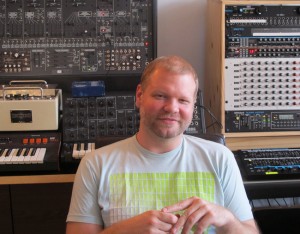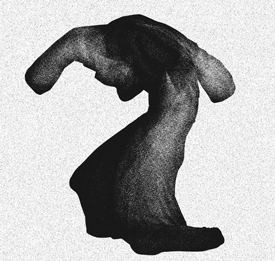Inside Spacebar Studios, Yeasayer’s Fragrant World & “Indie” Recording In Brooklyn
GREENPOINT, BROOKLYN: Producer/engineer Abe Seiferth graduated from engineering records at DFA Studios to setting up his own spot in Greenpoint – just as DFA alum Eric Broucek did before him. In fact, when Broucek moved out to L.A. last year, Seiferth took over his studio space, refashioned and reconfigured it as his own Spacebar Studios.
Here, Seiferth has worked on a number of notable album projects this year, including Turing Machine’s What is The Meaning of What, Dana Buoy’s Summer Bodies, and the new Yeasayer album, Fragrant World – due out next month.
Coming out of DFA, Seiferth built Spacebar to cater to the indie clientele he was cultivating as a producer – and as such, the studio represents a very modern approach to record making in Brooklyn today.
“We do a lot of synth-based music here,” Seiferth says, sitting in a room filled with synths.
“And these cabinets are filled with pedals. I’d rather get a bunch of pedals and a new synth than buy another Neumann U87. I’m going to make a cooler record if I get an interesting delay pedal, or an [Korg] MS-20 than if I pick up another Neve pre.”
Coming up as a guitarist and now moonlighting as one-half of electro-act Tippy Toes (which performs house music live on analog gear) Seiferth has more a musician’s than engineer’s approach to production. In Brooklyn, working on the music he does, this orientation puts him in the right place at the right time.
“The whole idea of this studio is based around the fact that everyone’s recording themselves – and getting pretty good at it. And it’s very often the better the band, the better they are at recording themselves, and the better their demos are. But the #1 thing people don’t seem to trust themselves with is mixing. So we do a lot of mixing here, we record a lot of drums, and we record a lot of vocals.”
Spacebar has a creative layout, based around a large control room with easy access to a wide (but not distracting) sonic palette via racks of analog synths and synth modules, and a live room that can handle a full drum kit and then some. Seiferth records and mixes in Logic Pro, with some choice hardware processing and a Dangerous D-Box making up his analog summing/mixing chain.
“Everything here is wired to MIDI,” Seiferth continues. “So, if we’re working on music made in Logic, I can listen to a software instrument track and say this sounds like an ARP 2600 or a Juno, and I can send the track to any of the analog synths I have here in the studio. And it really brings things to life, a lot of the time.”
He cites this among the many things learned from his time at DFA. “There’s a real value in having these real synths with all the synth-based music that’s happening,” he shares, noting that real instruments can sometimes lead to more interesting performances.
“When you’re recording synths here, with all these knobs, the temptation to move one ever so slightly throughout a song – that doesn’t really happen when you’re working with a software synth.”
On Working With Yeasayer
Yeasayer had been recording their new album at Kemado Records’ private (vintage Neve-equipped) studio in Greenpoint before moving over to Spacebar, where Seiferth engineered two of the album tracks and finished a third. The avant-pop band brought in demos consisting of soft synths, drum machines and a scratch vocal, and set out to re-build each song, track by track – using Spacebar exactly the way it was intended.
“Besides being excellent songwriters, the guys from Yeasayer have great ears for unique sounds working together,” Seiferth says.
“On the new album, there will be elements of their tropical disco sound, but there are also some hints of dubstep with some of the rhythms they’re doing, and then pop sounds as well. And that sounds like it could be a nightmare to have that all work together (laughs), but they totally make it all work in a really interesting way.”
The album features a lot of drum machines and electronic percussion, but the band also tracked live drums for one of the songs, “Reagan’s Key,” at Spacebar.
“I have a small room here, but try to make that as much a strength as possible in recording very dry, 70s-sounding drum sounds,” Seiferth describes.
“I’ve definitely been influenced by James [Murphy] in the way I tune and record drums – as in, the approach of doing drums concert-style (concert toms where you take the bottom head off) – which is something they did a lot in the 70s. It makes for a deader sound, with less overtones in the kit, which works really well with samples and synths, and in dance music when you’re layering sounds.
After their album had been mixed, Yeasayer was rehearsing the new songs for an upcoming tour and realized that one of the songs, “No Bones,” needed a little something extra at the end. They called Seiferth.
“They had a melody worked out and had the idea to do it with a talkbox sound,” he shares. “I happened to have the Rocktron Banshee. I bought it on a whim the week before because of a Zapp & Roger kick I had been on. I thought it would make a nice addition to the studio. It took a moment to get it to record right, but once it came together the results were great.”
On The State of Bedroom Music
In more ways than just its name, Spacebar is emblematic of its time and place. This is a studio where you could produce an album start-to-finish, but where you’d more likely fill in the blanks, replace sounds, and mix an album you’ve started in a home studio.
“This is a very efficient place, where everything has a very specific purpose,” says Seiferth.
“The music that I work on, or listen to, tends to be made track by track. Sounds are more specific. There are less albums in my world where people are recording in a more traditional fashion – knocking out basics on days one-three, then guitars, then scratch vocal, etc.
“To me, that’s not where music seems to be headed.”
That’s “music” he’s talking about, not just synth-based music.
“I think my experience is indicative of indie music in general,” Seiferth clarifies, citing a recent record he made with Akron/Family drummer Dana Buoy.
“People are making more bedroom music, for better or for worse. And there’s that step of getting out of their bedroom and into a studio, which is the other concept behind this studio – that all those things you’re working on at home, we can make them better here.
“Electronic music is filtering down through aspects of rock and indie music, and it has to do with the accessibility, ease-of-use and quality of electronics and computers these days. And it’s affecting what indie music is. Now “indie music” can be… ‘I made a whole album on a laptop.’ To me, that’s just as indie as someone making an album on a 4-track.
“It’s as indie as indie’s ever been.”
Follow Abe Seiferth on SoundCloud and Tumblr.
Please note: When you buy products through links on this page, we may earn an affiliate commission.








